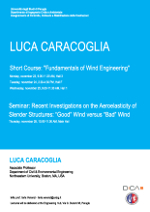 From Monday, November 23rd to Wednesday, November 25th, Prof. Luca Caracoglia, from Northeastern University, in Boston, USA, will teach a Short Course on Wind Engineering for undergruaduate and graduate students. On Thursday 26th at 10 AM in the Main Hall, Prof. Caracoglia will deliver a seminar titled: Recent Investigations on the Aeroelasticity of Slender Structures: “Good” Wind versus “Bad” Wind. All undergraduate and graduate students, as well as all interested faculty members are welcome.
From Monday, November 23rd to Wednesday, November 25th, Prof. Luca Caracoglia, from Northeastern University, in Boston, USA, will teach a Short Course on Wind Engineering for undergruaduate and graduate students. On Thursday 26th at 10 AM in the Main Hall, Prof. Caracoglia will deliver a seminar titled: Recent Investigations on the Aeroelasticity of Slender Structures: “Good” Wind versus “Bad” Wind. All undergraduate and graduate students, as well as all interested faculty members are welcome.
Program of the Short Course:
Monday, november 23, 9.00-11.30 AM, Hall 3
Tuesday, november 24, 2.30-4.30 PM, Hall F
Wednesday, november 25, 9.00-11.30 AM, Hall 1
Short bio:
Luca Caracoglia is currently an Associate Professor in the Department of Civil and Environmental Engineering of Northeastern University, Boston, Massachusetts, USA. He joined Northeastern University in 2005. Prior to this appointment, he was a post-doctoral fellow in the Department of Civil Engineering at Johns Hopkins University, Baltimore, Maryland (USA) in 2001-2002 and a post-doctoral research associate in the Department of Civil and Environmental Engineering at the University of Illinois (Urbana-Champaign, USA) in 2002-2004. He received his Ph.D. in Structural Engineering from the University of Trieste, Italy in 2001. His interests are in structural dynamics, random vibration, wind engineering, fluid-structure interaction of civil engineering structures, nonlinear cable network dynamics, energy harvesting systems in wind energy. Luca Caracoglia received the NSF-CAREER Award for young investigators in 2009.
Abstract of the Seminar (Thursday 26th, 10 AM, Main Hall):
Wind engineering is best defined as “the rational treatment of interactions between wind in the atmospheric boundary layer and man and his works on the surface of Earth”. This presentation will describe an overview of recent study activities in the field of the aeroelasticity of slender structures. Slender systems are usually large-period and low-damping structural systems, sensitive to vibration, fluid-structure interaction and susceptible to damage induced by destructive loads of “bad” winds. Nevertheless, if appropriately designed, slender structural systems might also be used to harvest the energy resource offered by “good” winds.
In recent years, research activities have been dedicated to the examination of several methodologies for predicting the aeroelastic response of slender structures by taking into consideration modeling and measurement “errors”. These “errors” are unavoidable since the loading is often evaluated experimentally by wind tunnel tests. Even though modern experimental techniques have attained adequate levels of sophistication and (statistical) confidence, loading uncertainty analysis is still relevant, especially for the interpretation of discrepancies, sometimes observed, between full-system vibration and numerical predictions. The investigated methods are both analytical (stochastic calculus) and numerical (Monte Carlo). Examples will include wind-related interactions on the envelope of a tall building and aeroelastic vibration of long-span bridges. Remarks will be used to formulate a “paradigm shift”, from avoiding “bad” winds to exploiting the wind resource. The same aeroelasticity principles can in fact be used to design “flutter-mills” as a potential alternative to other wind energy systems.